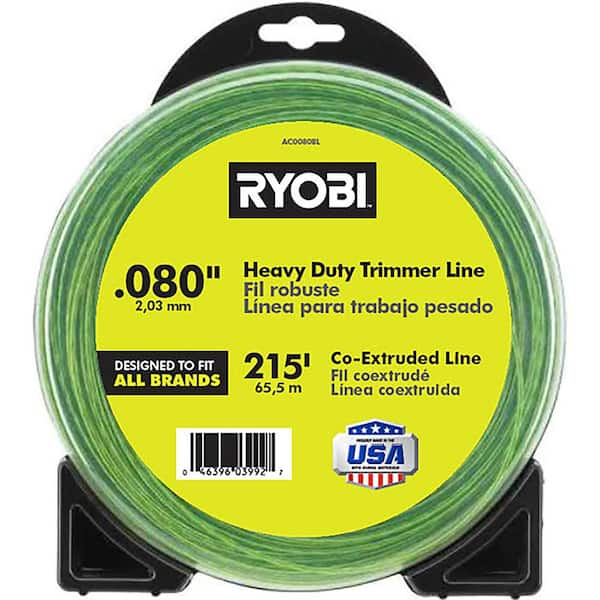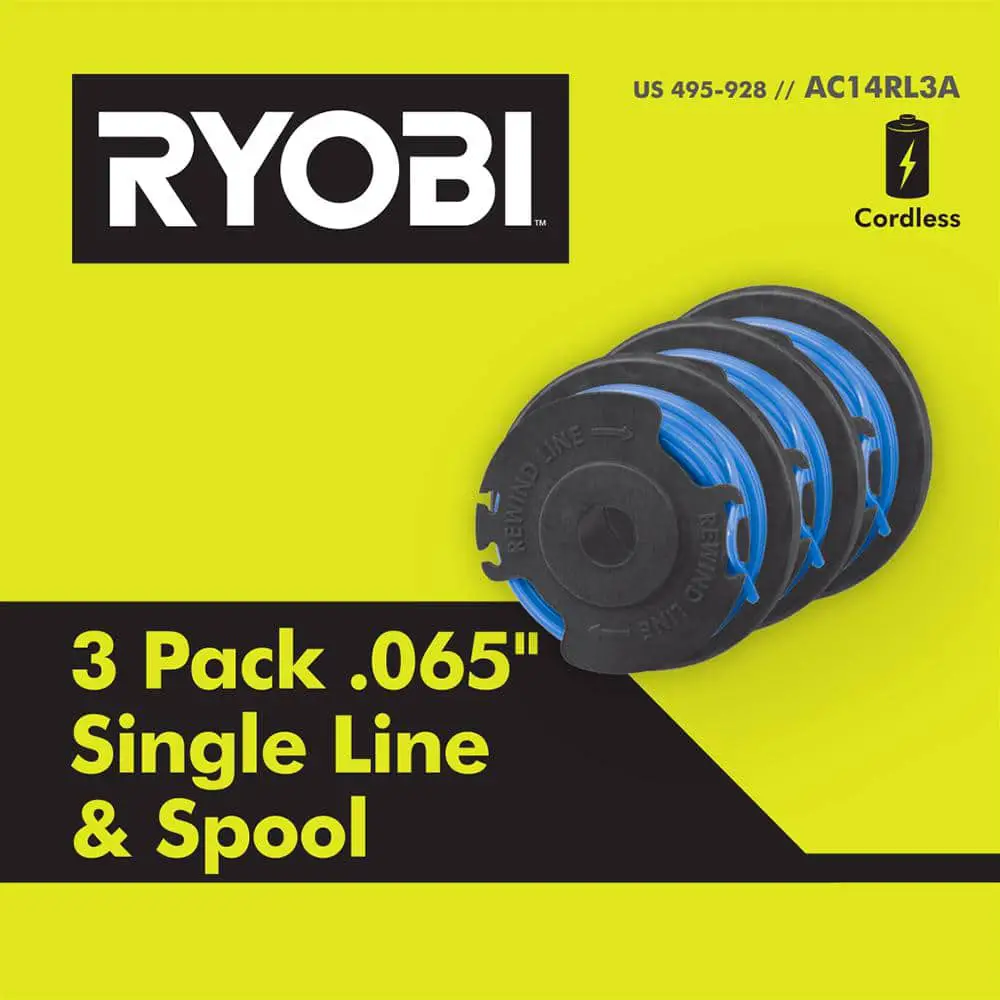When you’re ready to tackle the overgrown grass in your yard, you want your Ryobi weed eater to perform at its best. But have you ever wondered if you’re using the right string size for the job?
Choosing the correct string can make all the difference in achieving a clean, precise cut and saving you time and frustration. We’ll dive into what size string you should be using for your Ryobi weed eater to maximize its efficiency.
Get ready to discover the secrets of seamless lawn care and transform your yard work experience. Keep reading to find out how you can make the most out of your Ryobi tool!
Contents
Ryobi Weed Eater Models
Ryobi Weed Eaters are popular for their reliability and ease of use. They come in different models suited for various gardening needs. Understanding the right string size for each model is crucial. This ensures optimal performance and longevity.
Popular Models
Ryobi offers a variety of weed eater models. The Ryobi 18V ONE+ Cordless String Trimmer is highly favored. It’s lightweight and perfect for small lawns. The Ryobi 40V Cordless String Trimmer has more power for larger areas. The Ryobi Gas Powered String Trimmer is ideal for heavy-duty tasks. Each model serves different purposes.
String Compatibility
Choosing the correct string size is important. The Ryobi 18V ONE+ model typically uses a 0.065-inch string. It’s suitable for light trimming tasks. The 40V model often requires a 0.080-inch string. This size handles tougher weeds. The Gas Powered model can use a 0.095-inch string. It’s perfect for thick brush and heavy weeds. Always check the manual for precise string size recommendations.

Credit: www.youtube.com
Importance Of Correct String Size
Choosing the correct string size for a Ryobi weed eater ensures optimal performance and efficiency. Incorrect sizes can lead to poor cutting and potential damage. Always refer to the manufacturer’s guide for the best results.
Choosing the right size string for your Ryobi weed eater is crucial. It might seem like a minor detail, but it can significantly affect your gardening experience. Using the correct string size ensures that your tool performs efficiently and lasts longer.Performance Impact
Selecting the correct string size directly affects your weed eater’s performance. A string that’s too thick can slow down the motor, reducing its cutting speed. On the other hand, a string that’s too thin might not cut effectively, leaving your garden looking unkempt. Have you noticed your weed eater struggling or making odd sounds? This could be due to using the wrong string size. Matching the right string with your Ryobi model ensures that it operates smoothly and efficiently.Avoiding Equipment Damage
Using the incorrect string size can lead to equipment damage. A thicker string can cause unnecessary strain on the motor, leading to potential malfunctions. This might result in costly repairs or even the need to replace your weed eater. Consider this: a friend once used an overly thick string in their Ryobi weed eater, thinking it would cut better. Instead, it led to a burnt-out motor. Such scenarios highlight the importance of sticking to the manufacturer’s recommended string size. How often do you check the string size before use? Paying attention to this detail can save you from unexpected equipment failures. Always refer to the user manual or consult Ryobi’s guidelines for the best string size for your model.Standard String Sizes
Choosing the right string size for your Ryobi weed eater matters. It ensures efficient trimming and less strain on the machine. Understanding the standard string sizes helps you make the best choice. The size affects performance and durability. Let’s explore the common diameters and materials.
Common Diameters
The diameter of the string impacts cutting power. Common sizes range from 0.065 inches to 0.095 inches. Thinner strings, like 0.065 inches, suit light trimming tasks. They work best on grass and small weeds. Medium-sized strings, around 0.080 inches, handle thicker weeds. For dense areas, a 0.095-inch string is ideal. It offers more durability and power.
Material Considerations
String material influences performance and lifespan. Nylon is the most common choice. It’s flexible and affordable. Some strings include additives for strength. Titanium and aluminum are popular additives. They enhance durability and reduce breakage. Consider your yard’s needs. Choose a material that balances cost and performance.

Credit: www.homedepot.com
Choosing The Right String
Choosing the right string for your Ryobi weed eater can make a big difference in how efficiently you maintain your yard. Whether you’re tackling thick weeds or just trimming grass edges, the string type and size play a crucial role in achieving the results you want. Let’s break it down into practical insights that will help you make the best choice for your needs.
Assessing Your Yard Needs
Start by evaluating the type of work your yard requires. If your yard is mostly grass with occasional weeds, a thinner string might suffice. A 0.065-inch string is typically ideal for light grass trimming. On the other hand, if your yard is more like a jungle with dense weeds and overgrowth, consider using a thicker string, around 0.080 inches or more.
Take a walk around your yard and picture the string battling those stubborn weeds. You wouldn’t want a string that snaps every few seconds, right? The right string size can save you time and frustration, making yard maintenance a breeze.
Frequency Of Use
Think about how often you plan to use your Ryobi weed eater. If you’re a weekend warrior who trims occasionally, a standard string might meet your needs. However, if you’re out there every week, buzzing through the yard, investing in a more durable string can be worthwhile.
Consider your past experiences. Have you found yourself replacing strings frequently? A tougher string might last longer and handle frequent use better. It’s all about balancing durability with efficiency.
Ask yourself: Do you want to spend more time trimming or enjoying your yard? Choosing the right string can impact how much time you spend maintaining your outdoor space.
Ultimately, the right string for your Ryobi weed eater can enhance your yard care routine. It’s not just about cutting; it’s about cutting smartly. Make your choice wisely, and enjoy the satisfaction of a well-trimmed yard.
Installing String On Ryobi Weed Eater
Selecting the right size string for a Ryobi weed eater ensures efficient trimming. Typically, a 0. 080-inch string works well for light tasks, while a 0. 095-inch string suits thicker grass and weeds. Check your weed eater’s manual for specific recommendations.
Installing the string on your Ryobi Weed Eater might seem tricky at first, but with a little guidance, you’ll find it straightforward. Whether you’re a seasoned gardener or new to lawn care, knowing how to replace the string efficiently saves you time and effort. Imagine the satisfaction of a perfectly manicured lawn without the frustration of tangled or broken string.Step-by-step Instructions
Start by turning off your Ryobi Weed Eater and unplugging it if it’s electric. Safety is your first priority. Then, locate the spool cover at the base of the trimmer head. Press the tabs on the side to release it. Next, remove any old string that remains. Measure and cut a new piece of string, usually around 9 to 12 feet long, depending on your model. Check your owner’s manual for the exact length. Insert one end of the string into the anchor hole on the spool and begin winding it evenly in the direction of the arrow indicated on the spool. Once you’ve wound the entire string, leave about six inches of loose string. Thread this through the eyelet on the trimmer head. Reattach the spool cover by snapping it back into place. Ensure it’s secure before powering up your trimmer.Troubleshooting Tips
Having trouble with the string feeding correctly? Check if it’s wound tightly and evenly on the spool. A loose or uneven wind can cause the string to jam or break. If the string keeps breaking, consider the material you’re cutting. Thick weeds may require a heavier gauge string. Also, ensure the string is compatible with your Ryobi model. Experiencing constant tangling? Double-check the string’s path through the trimmer head. Incorrect threading can lead to tangles and inefficiency. Is the spool cover loose? A secure fit prevents the spool from wobbling and causing tangles. By mastering these simple steps and tips, your Ryobi Weed Eater will perform at its best. Have you ever faced a string mishap while trimming? Share your experience in the comments below. Your insights might just help someone else tackle their yard work with ease!Maintenance Tips
Choosing the right string size for your Ryobi weed eater ensures smooth operation and efficient trimming. A 0. 065-inch line is ideal for light tasks, while a 0. 080-inch line handles thicker grass. Always refer to the manual for specific recommendations to avoid damage.
Maintaining your Ryobi weed eater is crucial for its longevity and performance. Proper care not only ensures efficiency but also saves you time and money on replacements. Let’s dive into some maintenance tips that will keep your Ryobi weed eater running smoothly and effectively.Extending String Life
The right string size is essential for optimal performance. Regularly check your string for wear and tear. If it looks frayed or too short, it’s time for a replacement. Use the recommended string size for your specific Ryobi model. This ensures the string feeds correctly and doesn’t break easily. A thicker string might seem more durable, but it can strain the motor. To extend the life of your string, avoid hitting hard surfaces like concrete or rocks. These can quickly wear out or snap the string. Instead, gently guide the weed eater along edges and obstacles.Storing Your Weed Eater
Proper storage of your weed eater can prevent unnecessary damage. Always clean the tool before storing it. Remove any debris, grass, or dirt that might have accumulated. Store your weed eater in a cool, dry place. Excessive heat or moisture can damage both the string and the internal components. A garage or shed is ideal, away from direct sunlight and rain. Consider hanging your weed eater on a wall to save space and avoid accidental damage. This simple step can keep it safe from being knocked over or stepped on. Does your weed eater have a removable battery? If so, store it separately and charge it periodically. This keeps the battery healthy and ensures your tool is ready when you need it. Taking these small steps can make a big difference in the lifespan and performance of your Ryobi weed eater. Have you ever neglected a tool and regretted it later? Share your stories and tips in the comments below!Expert Recommendations
Choosing the right string size for your Ryobi weed eater is crucial. It affects performance and efficiency. Experts often suggest matching the string size to your specific model. This ensures optimal cutting and reduces wear on the machine.
Using the wrong size can lead to problems. It can cause poor trimming results and even damage. To avoid these issues, follow expert guidelines.
Professional Insights
Professionals recommend consulting your Ryobi model’s manual. It provides exact specifications for string size. Most Ryobi weed eaters use 0.065-inch or 0.080-inch strings. These sizes suit residential trimming needs well.
For heavier-duty tasks, consider 0.095-inch strings. They are thicker and more durable. Experts advise using this size for larger gardens or tougher weeds.
User Reviews
Many users share their experiences online. They often mention that the 0.065-inch string works well for light jobs. It’s ideal for smaller yards with minimal obstacles.
Users with larger properties prefer the 0.080-inch string. It offers a balance between durability and flexibility. For the toughest weeds, the 0.095-inch string receives high praise. Users note its strength and longevity.
Reviewers also emphasize checking compatibility. Not all strings fit every Ryobi model. Double-check your weed eater’s requirements to avoid issues.

Credit: www.amazon.com
Frequently Asked Questions
What Size String Fits A Ryobi Weed Eater?
The ideal size string for a Ryobi weed eater is usually 0. 065 inches. This size is perfect for light trimming tasks and ensures optimal performance. Always refer to your specific model’s manual for the best string size recommendation.
Can I Use A Thicker String On My Ryobi?
Using a thicker string may harm your Ryobi weed eater. Ryobi recommends sticking to the manufacturer’s specified size to avoid damage. A thicker string can strain the motor, causing inefficiency and potential breakdowns. Always consult the user manual before making any changes.
How Often Should I Replace The Ryobi String?
Replace the string on your Ryobi weed eater when it shows signs of wear or breaks frequently. Regular checks ensure the machine operates efficiently. Frequent use and tough conditions may require more frequent replacements. Always carry spare string for uninterrupted gardening.
Is Ryobi String Compatible With Other Brands?
Ryobi string may fit some other brands, but compatibility isn’t guaranteed. Different brands have specific requirements and specifications. Using the wrong string can affect performance and damage your equipment. Always check compatibility before purchasing or using alternative string brands.
Conclusion
Choosing the right string size enhances your Ryobi weed eater’s performance. Keep your yard tidy and edges sharp. Match your string size with the model’s specifications. This ensures efficient cutting and prolongs the tool’s life. Always consider the type of grass and weeds in your garden.
Thicker strings tackle tough, overgrown areas. Thin strings work well for regular trimming. Regular maintenance is key. Check the manual for guidance. A well-maintained weed eater makes yard work easier. Enjoy your neatly manicured lawn with the right string size.

